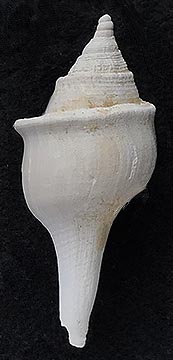The Late Cretaceous, Paleocene, and Eocene (see the time diagram shown below) world oceans were influenced by a warm equatorial (tropical) current known as the Tethys Current, which flowed westward from the Tethys Sea in Asia and Western Europe and continued westward into southern Mexico and Central America. This current dispersed the larvae of marine mollusks and other biota into the west coast of North America, as far north as Washington. This dispersal coincided mainly with the early Eocene, the warmest time of the last 65 million years of Earth history.
The position of the Tethys Current is shown below. There was an open
seaway connection between the Atlantic and the Pacific oceans in the area now known as Central America and South America. Shallow-marine mollusks found in Eocene rocks show very strong affinities to their counterparts in the Gulf Coast of the United States and in Western Europe (i.e., southern England, France, and Italy).
Since the 1920’s, in the Gulf Coast, and the 1930’s in California, invertebrate paleontologists studying large foraminifera, corals, mollusks, crabs, and echinoderms, have noted very similar looking species in these regions versus that of southern England and France. During the last 40 years, I have focused my own research largely on establishing the details of this influx of Western European thermophilic (warm water) genera and their related species into the west coast of the United States, especially into southern California.
By the means of detailed geologic mapping, extensive collecting, and analyses of the collected fossils, I and my students have been able to determine that the most extensive influx of mollusks from the Old World was during the warmest time of the Eocene; namely, the early Eocene [especially during an interval of geologic time known as the “Capay Stage,”] about 45 million years ago. This stage coincided with the Early Eocene Climate Optimum (= EECO). Subsequent tectonic activity displaced the rocks containing these fossils northward several hundred miles and also rotated some of the rocks nearly 90 degrees clockwise. This tectonic displacement was not recognized (by paleomagnetic studies) until the 1990’s.
Among the most famous of the mollusks that were introduced into are the gastropods Velates, Campanile, Gisortia, and Clavilithes. There are also many others, but these four genera are representative. At the end this post, I figure and discuss these genera.
Reference:
Savazzi, E. 1992. Shell construction, life habits and evolution in the gastropod Velates. Palaeogeography, Palaeoclimatology, Palaeoecology 99:349-360. Costs $$ to view online.
Comparison Between Western Europe and California Eocene Gastropod Species:
Velates perversus Paris Basin, France, two views: side and aperture.
The name “Velates” is derived most likely from the word “velum,” which is a veil or membrane covering; sort of like a length of cloth attached to a hat, thus covering the neck and shoulders (like the extension of the helmet of the character "Darth Vader" in the “Starwars” movies). Adult Velates shells normally a lateral (sideways) sloping extension.
Velates belongs to family Neritidae, which most collectors refer to as nerites, whose living members (several hundred species) are small with brightly colored shells that can be found in trees, springs, rivers, swamps, marshes, and brackish water. Most species are found, however, in shallow-marine waters, especially along intertidal coastlines in tropical seas.
Velates ranges in time from, possibly Late Cretaceous, but with certainty from Paleocene to Eocene in Europe, Africa, Asia, North America, and the Caribbean region. Velates is peculiar for nerites: it has the largest shells of any nerite (fossil or living), the aperture occupies about one-third of the base of the shell, with the rest consisting of a thick callus.
Their largest shells reached about 150 mm in diameter; making Velates the largest neritid. Its shell is unusual for a nerite because of its considerable thickness, especially on its ventral surface, where a broad thick callus (shell buildup) creates a very wide, smooth surface (pad). Whereas nearly all nerites are free to crawl around, it appears that Velates was rather comfortable in settling partially into the sediment substrate (i.e., the basal callus pad created an “anchor” of sorts). Thus, Velates might have been a partial burrower in soft-bottomed sediments. The thick callus would could have served as an “anchor.” Other evidence to support a burrowing lifestyle is that its outer surface of the shell is smooth and shiny and never show attached epibionts (unless they occurred post-mortem). There are only a few nerites that live today as infaunal soft-bottom dwellers, but these nerites are small in size.
The Velates specimens that I and my students were fortunate to find and collect were present only in transgressive (deepening upsection) facies in shallow-marine water environments near the bases of formations. They are not scattered throughout a formation which has different environments of deposition.
The genus Gisortia belongs to family Cypraeidae (i.e., popularly known as the cowries). The global geological time range of Gisortia is Late Cretaceous (Maastrichtian) to late Eocene, but on the west coast of North America this genus occurs only in lower Eocene (“Capay Stage”) strata in southern Baja California, Mexico and in southern and central California. Gisortia is a large-sized gastropod shallow-marine gastropod.
Clavilithes lived from Paleocene to Pliocene, with various species found in Africa, Asia, Europe (especially southernmost England and also the Paris Basin, France), North America, and South America. In California, it is restricted to the early Eocene and to the lower part of the middle Eocene. It is a very distinctive genus, with tabulate shells ± fine spiral ribs. Individuals can reach up to 85 mm in height and 35 mm in width.
Campanile has a geologic range from Late Cretaceous (Maastrichtian) to recent. Today, it occurs only in the Perth area of southwestern Australia. On the Pacific coast of North America, it is found in Paleocene an Eocene deposits, in California and Baja California Sur, Mexico.















No comments:
Post a Comment